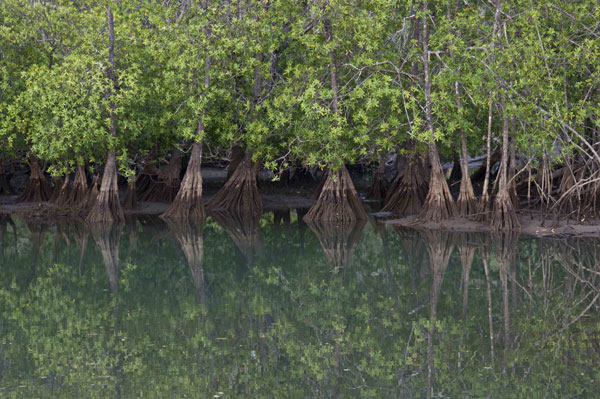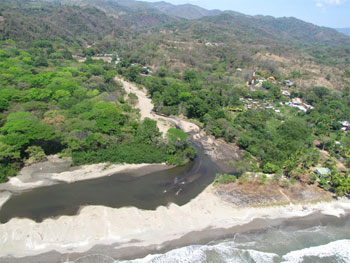
A study conducted in Guanacaste by Costa Rican and American universities determined that one of the factors that causes intense water-related conflicts in the province is the friction between communities. The study was conducted with the goal of impacting local and regional water management, as well as several institutions that centralize the resource’s management. Ignorance of how much water is really available for project development and a lack of trust among stakeholders are additional factors that may complicate conflicts.
In the early 2000s, after significant population growth and a real estate and foreign investment boom, it became clear that Guanacaste had entered a new era in environmental governance.
This period has been characterized by a panorama of water-related conflicts and, if we consider that Guanacaste is located in the “dry tropics” region, the expected results were to have different pressures in the area.
Drastic landscape transformation, the establishment of rural groups and associations that seek to protect local water sources and frequent unilateral decisions regarding hydric resources by groups that exclude local communities are some of the conflict causing factors that have eventually escalated to great water-related problems, as was the Sardinal case (see textbox).
These results were obtained through a series of interviews with key people related to water conflicts in the area. These were then inserted into a framework along with government reports, newspaper articles and informal social networks.
In general terms, conflicts in the province (such as the Sardinal, Nimboyores (Santa Cruz) and Mala Noche (Samara) cases) have exposed important weaknesses in the water management system.
A limited integration among key stakeholders, such as the AyA and ASADAs, is one of the factors hindering local water management. In addition, the lack of management plans and conflict resolution processes, and a poor flow of information among the parties involved, worsens the situation.
The roles and responsibilities of those involved are often unclear. Furthermore, decision-making processes regarding local resources often occur behind closed doors when it comes to water sources, since widespread ignorance exists in relation to ecological aspects.
Therefore, there is a lack of trust between parties, as well as political illegitimacy and uncertainty. Past actions, such as the construction of aqueducts during evening hours, granting of permits for new projects on holidays such as Christmas and New Year and the exclusion of opposing parties, have led to escalating tensions that have caused water-related conflicts.
However, there are opportunities that may allow for a more sustainable resource management in the future, thereby reducing these conflicts.
New strategies should be directed by efforts that:
- Strengthen and take advantage of existing community associations.
- Plan basin management, taking all parties into account.
- Increase local capacity – for example, in the ASADAs.
- Invest in inclusive control programs to better understand groundwater resources.
- Promote the inclusion of local leaders and recruit new leaders who can develop innovative university-based programs.
- Implement controls to mitigate conflicts before they occur, also having the ability to solve unforeseen conflicts.
The necessary transformation when searching for sustainable strategies is an ongoing process. The study’s results include a series of strategies so that regional and community platforms trigger necessary changes.
| Mariel Yglesias and Christopher Kuzdas are associated researchers at Arizona State University and CATIE. Their work in the region is ongoing and focuses on finding development and sustainable management solutions for water resources in Guanacaste. For additional information please contact them at: [email protected] |
Introducing Water Access as a Basic Human Right
The amendment proposed to Article 50 (adding several paragraphs to Article 50 of the Constitution in order to recognize and guarantee water access as a basic human right), which is being discussed in Congress (Asamblea Legislativa), seeks to declare water access as a fundamental and inalienable right. In order for this proposal to have a real and effective scope, this effort must be implemented with concrete actions at both a regional and community level.
Case 1. Conflict in Sardinal
Year: 2008 -2011
Municipality of: Carrillo
Conflicts: Public-private partnerships for water use without regard for the community, generating uncertainty and mistrust.
Brief overview: In January 2008 the construction of an aqueduct that would carry groundwater from Sardinal to a resort in El Coco was nearly finished. However, the community was excluded from the project and remained uninformed until a public hearing was held with AyA. Subsequently, the aqueduct has been the setting for protests led by concerned neighbors and opposition groups. |
|
 |
|
Case 2.Nimboyores
Year: 2001-2006
Municipality: Santa Cruz
Conflicts: Concessions for the exploitation of an aquifer by a private entity in a complex, political legitimacy context, uncertainty and poor ecological knowledge.
Brief overview: The Melia Conchal resort received construction permits to build several wells over the Nimboyores aquifer, which would supply them with water. Local organizations were unaware of the decision. Therefore the community, led by a group of associations, blocked part of the construction and submitted a formal complaint to national agencies. Later they formed a negotiating committee that included both the community and national agencies. The first meetings between parties were tense and the community questioned studies that supported the project. Eventually, after a negotiation period, the involved parties agreed on the project. However, the private sector had already lost interest. |
Case 3. Mala Noche – Samara
Year: 2002-2012
Municipality of: Nicoya
Conflicts: Conflicts over land and water rights between the community and private interests, land use, pollution and vulnerability
Brief overview: Historically, the Mala Noche aquifer has been the setting for various conflicts. In the 60s the clear cutting of forests in order to establish a teak plantation impacted it, causing runoff, sedimentation and damage to the aquifer. The most recent conflict occurred in the early 2000s, when Samara Reefs resort was accused of polluting the aquifer with wastewater. Tensions rose when a concession was granted to carry water from the aquifer to the resort for the creation of artificial lakes. Thanks to the proactive opposition of local groups, development has been partly regulated. However, at times tensions have escalated and there is a lack of trust between the parties involved. |
|
 |
|
| 
